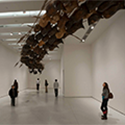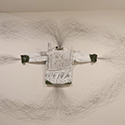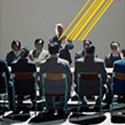|
|
| Show All 12 Results (Text Only) |
|
| Teaching Modern and Contemporary Asian Art |
|
|
What Is Modern Asian Art?
Modernism developed in the late 19th and early 20th centuries, amid the throes of the Industrial Revolution and the rise of progressive political movements. Industrialization, urbanization, rapid social changes, and advances in science and the social sciences overthrew established systems of order and meaning around the world, from Paris to New Delhi to Tokyo. In the arts, modernists and the avant-gardist idealized personal freedom and individualism, advocated the destruction of traditional orthodoxy to create radically new forms of culture, and championed the spirit of self-expression and experimentation." See also: Map of East Asia and Southeast Asia [PDF] and Teacher's Guide to Modern and Contemporary Asian Art [PDF].
Go to Museum Resource: https://www.guggenheim.org/teaching-materials/teaching-modern-and-contemporary-... | |
|
|
| The Third Mind: American Artists Contemplate Asia, 1860-1989 |
|
|
The Third Mind: American Artists Contemplate Asia, 1860–1989 considers the dynamic impact of Asian art, literature, music, and philosophy on the development of American art. This guide for educators focuses on seminal American artists who took inspiration from Asia and reflected that engagement in their creative work. Teachers guides reflect the structure of the exhibition, which is divided into seven chronological and thematic sections, and selects a representative artist from each. Looking at and discussing these works with students can enhance their understanding of American art and how its development has been influenced by specific sources of Asian art and thought. Video and audio content available. See also: Teaching Materials.
Go to Museum Resource: https://www.guggenheim.org/exhibition/the-third-mind-american-artists-contempla... | |
|
|
| V.S. Gaitonde: Painting as Process, Painting as Life |
|
|
An artist of singular stature, modernist painter Vasudeo Santu Gaitonde (1924–2001) was known to fellow artists and intellectuals, as well as to later generations of students and admirers, as a man of uncompromising integrity of spirit and purpose. Born in Nagpur, India in 1924, Gaitonde was briefly affiliated with avant-garde collectives such as the Progressive Artists’ Group and the Bombay Group in the early ’50s. Nonetheless, he remained independent throughout most of his career. PDF Downloads of exhibition history and artist chronology.
Go to Museum Resource: https://www.guggenheim.org/exhibition/v-s-gaitonde-painting-as-process-painting... | |
|
|
| Wang Jianwei: Time Temple |
|
|
The exhinit Wang Jianwei: Time Temple, is an immersive exhibition of new work by the Beijing-based artist and his first solo museum exhibition in North America. Informed by critical theory and philosophy, his work focuses on a process-based practice that expresses time and movement into the production and experience of art. Includes video resources. See also: Teaching Materials.
Go to Museum Resource: https://www.guggenheim.org/exhibition/wang-jianwei-time-temple | |
|
|
|
| Show All 12 Results (Text Only) |




